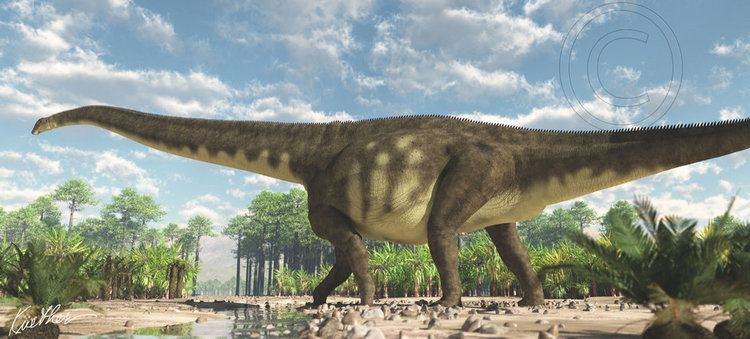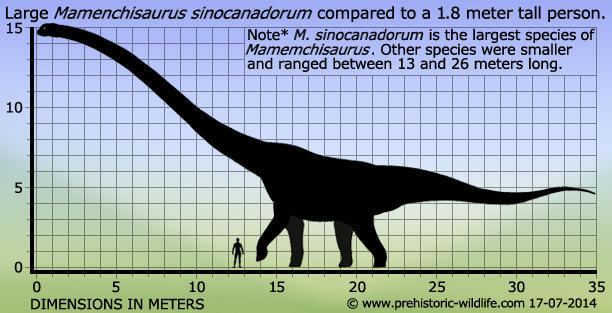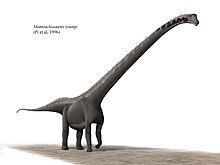Scientific name Mamenchisaurus | Phylum Chordata Rank Genus | |
Similar Omeisaurus, Sauropoda, Diplodocus, Brachiosaurus, Camarasaurus | ||
Mamenchisaurus (/mɑːˈmʌntʃiˈsɔːrəs/ mah-MUN-chi-SAWR-əs,[1] or spelling pronunciation /məˌmɛntʃiˈsɔːrəs/) is a sauropod dinosaur genus including several species, known for their remarkably long necks which made up half the total body length. It is known from numerous species which ranged in time from 160 to 145 million years ago, from the Oxfordian to Tithonian ages of the late Jurassic Period of China, and the largest species may have reached 35 m (115 ft) in length and possibly weighed 50 to 75 tons.
Contents

Dinosaurs museum mechanical mamenchisaurus 1
Discoveries

Mamenchisaurus was first discovered in 1952 on the construction site of the Yitang Highway in Sichuan, China. The partial skeleton fossil was then studied, and named Mamenchisaurus constructus in 1954, by the renowned Chinese paleontologist Professor C. C. Young. The type specimen had an incomplete neck with 14 vertebra preserved and none of these were complete. M. constructus has been estimated around 13 m (43 ft) and 15 m (49 ft) in length.

In 1972, a second species was described, named Mamenchisaurus hochuanensis, with a neck that reached up to 9.3 m (31 ft) in length. This species had a complete neck preserved which contained 19 vertebrae. This was the longest neck known until the description of Supersaurus, based on a single neck vertebra, BYU 9024, with an estimated neck length of about 14 meters (46 feet). Another long-necked sauropod exceeding M.hochuanensis was Sauroposeidon which was discovered in 1994. Based on the Sauroposeidon holotype, which only preserved 4 neck vertebra, its neck was estimated to be between 11.25 and 12 meters (36.9–39.4 feet) long.

In 1993, M. sinocanadorum was described, which consisted of skull material and the first four cervical vertebrae. This species possessed the longest cervical rib of any described sauropod dinosaur, measuring 4.1 m (13.5 ft). This is longer than the longest Sauroposeidon cervical rib, which measures 3.42 m (11.2 ft). Additional remains attributed to this species, but not yet formally described, belong to one of the largest dinosaurs known—the restored skeleton measuring 35 metres (115 ft) in length with a neck measuring nearly 17 metres (56 ft) long.
In 2001, another M. hochuanensis specimen was described. It had skull, pectoral girdle and forelimb material preserved, all of which were missing from the holotype. It was also found with four fused tail vertebra, which have expanded neural arches and taller neural spines, that belong at the tip of the tail. It’s thought that these could be a weapon, such as a tail club, or a sensory organ. Other Chinese sauropods, Shunosaurus and Omeisaurus, are also known to have had ’tail clubs’ but they differ in shape to that of M. hochuanensis.
Naming
Mamenchisaurus means 'Mamenchi lizard', from the Chinese Pinyin mǎ (马 'horse') and mén (门 'gate'), while chi is a transliteration of xī (溪 'stream' or 'brook'), combined with the suffix -saurus (from Greek sauros meaning 'lizard').
It was intended to name the reptile after the place where its fossil was first found — a construction site next to the Mǎmíngxī (马鸣溪) Ferry Crossing by the Jinsha River (金沙江, the westernmost major headwater stream of the Yangtze River), near Yibin (宜宾) in Sichuan Province of China. However, due to an accentual mix-up by Young, the location name Mǎmíngxī (马鸣溪 'horse-neighing brook') was mistaken as Mǎménxī (马门溪 'horse-gate brook'). The fact that the first Mamenchisaurus fossil was found as the result of construction work led to Young's naming the type species as Mamenchisaurus constructus.
Species
Classification
The cladogram below shows a possible phylogenetic position:
